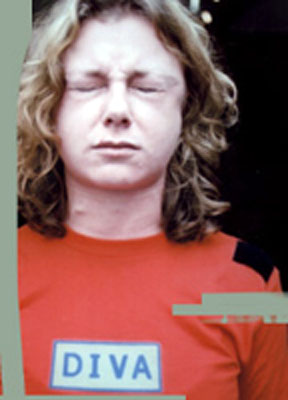A: Carlotta Sagna's inside-out dance-theater
A
Choreography and text by Carlotta Sagna
The Kitchen
October 1-4, 2003
By
Meital Waibsnaider
Copyright
©2003 by Meital Waibsnaider
Part rehearsal-on-display, part modern-dance performance and part late-night confessional, Carlotta Sagna's A explored performers' psyches whilehumorously toying with audience expectations. In a jumble of a show that touched on many aspects of performing and living, small kernels of truth shone throughout.
 Lisa
Gunstone and Antoine Effroy played the obliging performers to Sagna's
omnipresent director, who offered cues like, "This is a blackout,"
from a back-of-house tech table and sometimes the stage itself. Sagna's
lighting directions grew more descriptive throughout the hour-long program,
and gave the sensation that we were included in a work-in-progress, filling
in our own lighting and technical support to a barebones set with minimal
production elements.
Lisa
Gunstone and Antoine Effroy played the obliging performers to Sagna's
omnipresent director, who offered cues like, "This is a blackout,"
from a back-of-house tech table and sometimes the stage itself. Sagna's
lighting directions grew more descriptive throughout the hour-long program,
and gave the sensation that we were included in a work-in-progress, filling
in our own lighting and technical support to a barebones set with minimal
production elements.
From the beginning, Sagna established that A would bend to no clear, linear outline. Partway through Effroy's sinuous and wondrous opening solo, Gunstone entered, munching loudly on cookies and chatting matter-of-factly with Sagna.
"He's quite sexy. Have you seen his biceps?" the talk began.
The dancers' words often mingled with seductively pedestrian movement that covered the entirety of the stage with ease. Similarly, their monologues and conversations spanned a range of topics, from marriage to summer vacations, to the solitude of post-performance depression. Effroy pined for one girl to "share [his] whole life," but after a heavily acrobatic duet with a whiny and crying Gunstone, said he'd settle for a two-month affair-someone to share the months of July and August.
Gunstone's monologues proved less audience-friendly and direct in their content. Some recalled fights with lovers, while others evoked the angst of a performer yearning for an audience response after pouring out "all kinds of things, intimate stuff, very personal."
The highly energized and organic movement complimented the erratic text, with well-placed phrases of messy disarray that sometimes grew out of the performers' casual mannerisms. There were several costume changes, during which the dancers employed staple-guns to supposedly affix dresses and blazers to their simple T-shirts and slacks. Black Velcro squares, however, were easily identified on the dancers' base costumes, and we understood the staple-guns were merely a ruse.
Several times throughout the piece, Effroy and Gunstone praised each other profusely, and with Sagna's help showed us how it feels to inhabit the receiving end of such over-the-top adulation.
"Do you ever have the sense of being guilty of not being a genius, of not having completed anything?" Effroy asked Gunstone.
This universal sense of emptiness even after completing such a seemingly fulfilling act of performance pervaded A, revealing after all, the common link between audience and performer.
In response to Sagna's final call of "blackout," Effroy and Gunstone tripped over each other and bumped into walls, faithfully recounting on—and backstage antics normally kept secret from a paying audience. Full disclosure and inclusion, indeed.
Originally
published:
www.danceviewtimes.com
Volume 1, Number 2
October 6, 2003
Copyright
©2003 by
Meital
Waibsnaider
|
|